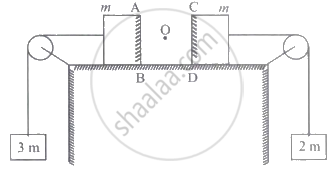Advertisements
Advertisements
प्रश्न
State and explain Newton’s second law of motion.
उत्तर
Newton’s Second law of motion states that the force ‘F’ acting on a body of mass ‘m’ producing acceleration ‘a’ is equal to the product of the mass and acceleration of the body. That is, F = ma
It can be derived from the concept of momentum.
Suppose a body of mass ‘m’ has initial velocity ‘u’ and after time ‘t’ its velocity becomes ‘v’. The initial momentum is, Pi = mu
The final momentum is Pf = mv
The change in momentum with respect to time ‘t’ is
= (mv − mu)/t = m (v − u)/t = F …….(1)
We know, acceleration, a = (v − u)/t
So, (1) implies,
F = m(v − u)/t = ma
Which is Newton’s Second law of motion.
APPEARS IN
संबंधित प्रश्न
An automobile vehicle has a mass of 1500 kg. What must be the force between the vehicle and road if the vehicle is to be stopped with a negative acceleration of 1.7 m s−2?
A large truck and a car, both moving with a velocity of magnitude v, have a head-on collision and both of them come to a halt after that. If the collision lasts for 1 s:-
(a) Which vehicle experiences the greater force of impact?
(b) Which vehicle experiences the greater change in momentum?
(c) Which vehicle experiences the greater acceleration?
(d)Why is the car likely to suffer more damage than the truck?
Fill in the following blanks with suitable words :
Newton’s second law of motion can be written as Force = mass × _____________ or Force = _____________ of change of _____________.
Explain the meaning of the following equation :
F = m x a
where symbols have their usual meanings
A car of mass 2400 kg moving with a velocity of 20 m s-1 is stopped in 10 seconds on applying brakes. Calculate the retardation and the retarding force.
How long will it take a force of 10 N to stop a mass of 2.5 kg which is moving at 20 m/s ?
If a balloon filled with air and its mouth untied, is released with its mouth in the downward direction, it
moves upwards. Why ?
Which of the following situations involves the Newton's second law of motion?
State Newton’s laws of motion?
Two blocks each of mass m lie on a smooth table. They are attached to two other masses as shown in the figure. The pulleys and strings are light. An object O is kept at rest on the table. The sides AB and CD of the two blocks are plane and made reflecting. The acceleration of two images formed in those two reflecting surfaces with respect to each other is ______.

